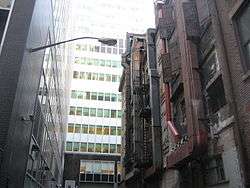Marketfield Street
Coordinates: 40°42′17″N 74°00′45″W / 40.704648°N 74.012568°W

Marketfield Street is a short one-way, one-block-long alleyway in the Financial District of Manhattan, New York City. The street begins as a southern branch of Beaver Street, then veers east and north, ending at Broad Street. Alternative past names include Exchange Street, Field Street, Fieldmarket Street, Oblique Road, and Petticoat Lane.[1]
In 1641, the Governor-General of New Netherland, Willem Kieft, founded on the street, located near Wall Street.[2] The street's name was literally "Market Square",[3][4][5] and it was named after the Dutch livestock market, Marcktveldt, which operated between 1638 and 1647 in an area near Battery Park.[1] By 1680, mainly poor people were living on the street.[6] Kieft lived in the city with many Huguenots. In 1688, they built the city's first French Huguenot church on the street.[7][8]
In September 1776, Marketfield Street was hit by a large fire, the Great Fire of New York, that engulfed the southwestern tip of Manhattan.[9] In 1821, a hurricane hit the East Coast. As a result, it was destroyed by the dock.[10] In 1821, Marketfield Street, which overlooked the Hudson River, were a single, through street.[11] By the 1830s, though, the street was renamed "Battery Place" from Bowling Green to the Hudson River.[1]
The 1882 construction of the New York City Produce Exchange demolished the block of the street that contained the church.[1] In the 20th century, 70 Broad Street, between Marketfield and Beaver Street, became the headquarters of the American Bank Note Company.[12]
References
| Wikimedia Commons has media related to Marketfield Street (Manhattan). |
- 1 2 3 4 Walsh, Kevin (May 1999). "The Alleys of Lower Manhattan". Forgotten NY. Retrieved 21 April 2015.
- ↑ Burrows & Wallace 2000, p. 36.
- ↑ Sanna Feirstein (2001). Naming New York: Manhattan Places and How They Got Their Names. NYU Press. pp. 28, 207. ISBN 0814727123.
- ↑ Moscow, Henry (1978), The Street Book: An Encyclopedia of Manhattan's Street Names and Their Origins, New York: Hagstrom, ISBN 0823212750, pp.75,119
- ↑ David T. Valentine (1853). HISTORY OF THE CITY OF NEW YORK. N. Y.: G. P. Putnam & Company.
- ↑ Burrows & Wallace 2000, p. 88.
- ↑ William Elliot Griffiths (1923). The Story of the Walloons: at Home in Lands of Exile and in America. Houghton. pp. 205, 340.
- ↑ Burrows & Wallace 2000, p. 95.
- ↑ Burrows & Wallace 2000, p. 241.
- ↑ David M. Ludlum (1963). Early American Hurricanes, 1492-1870. Boston: American Meteorological Society. pp. 85, 212.
- ↑ "8". Laws of the State of New York. Albany: E. Croswell. 1830. p. 8.
- ↑ Edwin G. Burrows, Mike Wallace (2000). Gotham: A History of New York City to 1898. The History of NYC Series. N. Y.: Oxford University Press. pp. 45, 1383. ISBN 978-0-19-514049-1.
- Burrows, Edwin; Wallace, Mike (2000). Gotham: A History of New York City to 1898. The History of NYC Series. N. Y.: Oxford University Press. p. 1383. ISBN 978-0-19-514049-1.